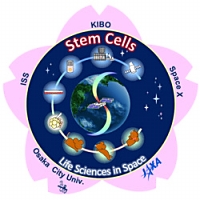This is an archive of information released in the past.
Disclaimer: It may contain broken links or outdated information. Some parts may not function in current web browsers.
*Visit https://humans-in-space.jaxa.jp/en/ for the latest information.

Experiment
- News
- Kibo Utilization Plan
- List of JAXA's Utilization Themes
- Experiment Facilities
- Space Environment Utilization
- Archive
Exploring the effects of the space environment on the offspring using stem cells
Study of the Effects of the Space Environment on Embryonic Stem Cells and Their Development (Stem Cells experiment)
![]() TOPICS:
TOPICS:
- Easy-to-understand lesson on space experiments: Stem Cells experiment
Pikaru, a member of the investigation team for the space experiments, interviews the Doctor to closely analyze the Stem Cells experiment. - Experiment started
On the ground, the Principal Investigator, research group members, and JAXA’s coordinators are making steady preparations for the space experiment. Recent developments are posted with pictures.
- Background
Space is an environment where we are exposed to many kinds of radiation, as well as the influence of microgravity. How will the radiation influence the human body? How can we protect our bodies from radiation? Can human beings reproduce in space? The answers to these questions are extremely important for human beings to perform a wider variety of activities in space in the future. - Objective
In long-term manned space activity on Kibo the presence or absence of an effect of cosmic radiation on the human body, particularly on germ cells associated with offspring, is an important problem. In this research, frozen pluripotent cells (embryonic stem cells: ES cells) will be preserved on Kibo for varying periods of time and then returned to Earth for analysis. - Outline of the Experiment [PDF: 123KB]
This research project is named after stem cells, which have become a topic of global interest. Embryonic stem (ES) cells, which are derived from embryos and used in this experiment, and induced pluripotent stem (iPS) cells, developed by Professor Yamanaka of Kyoto University, who won the Nobel Prize in Physiology or Medicine in 2012, are a kind of stem cells called pluripotent stem cells, which can differentiate into nearly all cell types.
This experiment began in March 2013 with the launching of the sample ES cells by the Dragon spacecraft (SpX-2).

Takashi Morita
Graduate School of Medicine, Osaka City University
Department of Molecular Genetics
Professor
Area of Research: Molecular biology (DNA repair)
Collaborating researchers:
Kayo YOSHIDA, Associate Professor of Department of Molecular Genetics, Graduate School of Medicine, Osaka City University
Kiyomi EGUCHI-KASAI, Center of Human Resources Development, National Institute of Radiological Sciences
Masaki SHIRAKAWA, Promotion of Life Science Mission, Space Environment Utilization Center, JAXA Francis. A. Cucinotta, Professor, Department of Health Physics and Diagnostic Sciences, University of Nevada, Las Vegas
Megumi HADA, Senior Scientist, Johnson Space Center, Wyle Integ. Sci. & Eng.
| Copyright 2007 Japan Aerospace Exploration Agency | Site Policy |
